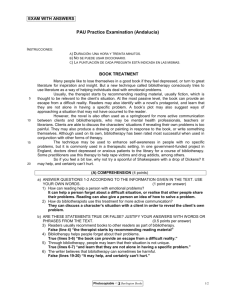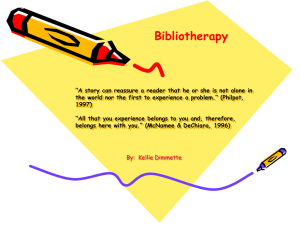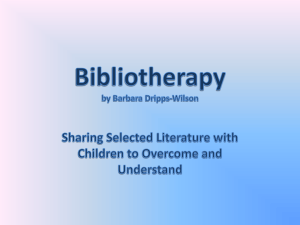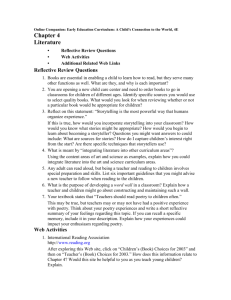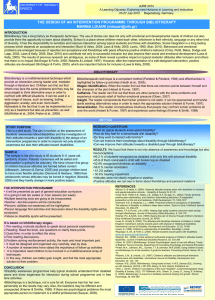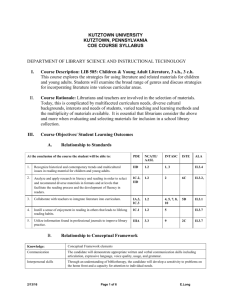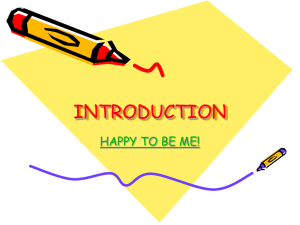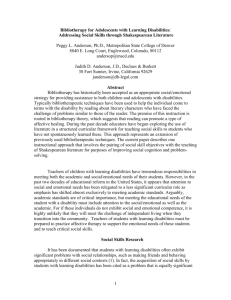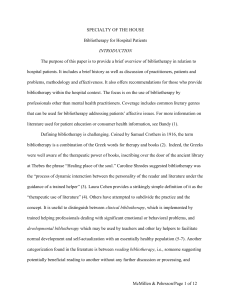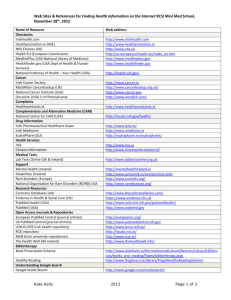Bibliotherapy Research Paper
advertisement
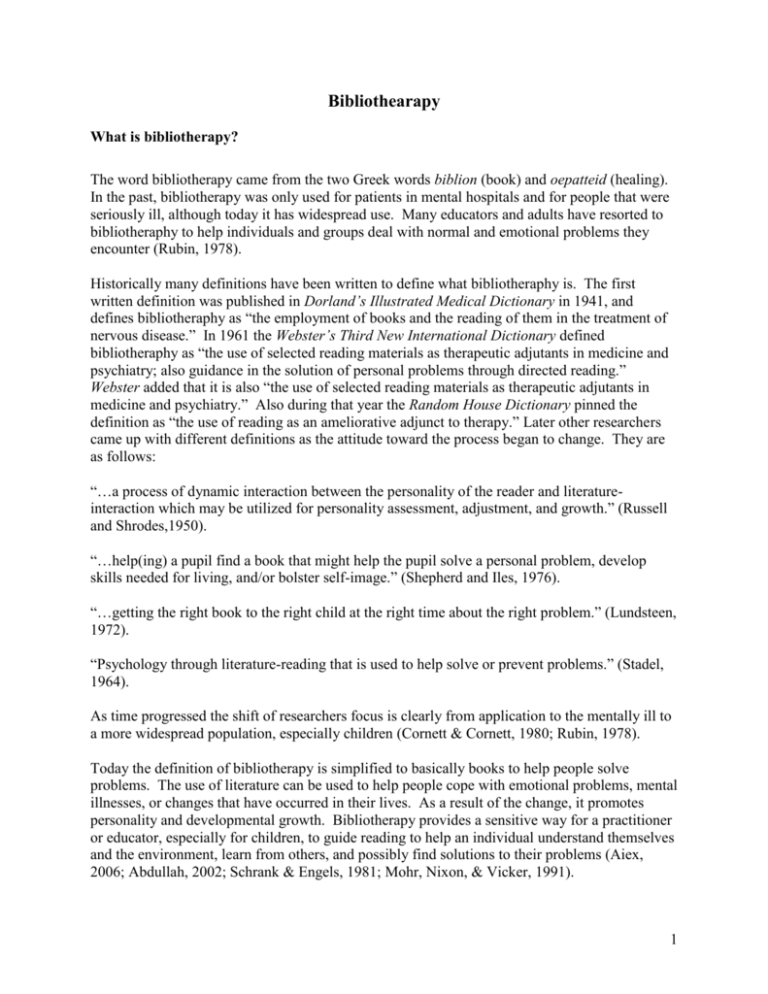
Bibliothearapy What is bibliotherapy? The word bibliotherapy came from the two Greek words biblion (book) and oepatteid (healing). In the past, bibliotherapy was only used for patients in mental hospitals and for people that were seriously ill, although today it has widespread use. Many educators and adults have resorted to bibliotheraphy to help individuals and groups deal with normal and emotional problems they encounter (Rubin, 1978). Historically many definitions have been written to define what bibliotheraphy is. The first written definition was published in Dorland’s Illustrated Medical Dictionary in 1941, and defines bibliotheraphy as “the employment of books and the reading of them in the treatment of nervous disease.” In 1961 the Webster’s Third New International Dictionary defined bibliotheraphy as “the use of selected reading materials as therapeutic adjutants in medicine and psychiatry; also guidance in the solution of personal problems through directed reading.” Webster added that it is also “the use of selected reading materials as therapeutic adjutants in medicine and psychiatry.” Also during that year the Random House Dictionary pinned the definition as “the use of reading as an ameliorative adjunct to therapy.” Later other researchers came up with different definitions as the attitude toward the process began to change. They are as follows: “…a process of dynamic interaction between the personality of the reader and literatureinteraction which may be utilized for personality assessment, adjustment, and growth.” (Russell and Shrodes,1950). “…help(ing) a pupil find a book that might help the pupil solve a personal problem, develop skills needed for living, and/or bolster self-image.” (Shepherd and Iles, 1976). “…getting the right book to the right child at the right time about the right problem.” (Lundsteen, 1972). “Psychology through literature-reading that is used to help solve or prevent problems.” (Stadel, 1964). As time progressed the shift of researchers focus is clearly from application to the mentally ill to a more widespread population, especially children (Cornett & Cornett, 1980; Rubin, 1978). Today the definition of bibliotherapy is simplified to basically books to help people solve problems. The use of literature can be used to help people cope with emotional problems, mental illnesses, or changes that have occurred in their lives. As a result of the change, it promotes personality and developmental growth. Bibliotherapy provides a sensitive way for a practitioner or educator, especially for children, to guide reading to help an individual understand themselves and the environment, learn from others, and possibly find solutions to their problems (Aiex, 2006; Abdullah, 2002; Schrank & Engels, 1981; Mohr, Nixon, & Vicker, 1991). 1 Bibliotherapy is techniques used for instructing interaction between a facilitator and a participant. It is implemented when a problem exists, the reader becomes personally involved with the situations and characters in the books, and a problem is addressed. Bibliotheraphy is not used for deep psychological problems or as a tool for self-motivated reading. If a book is recommended from a friend or librarian to help an individual with a possible situation, is also not bibliotheraphy. To truly experience bibliotherapy a plan from a facilitator must be implemented with an individual or group (Cornett et. al, 1980; Rubin, 1978). When should Bibliotheraphy be used and what are the positive and negative effects? Bibliotherapy can be used for a variety of reasons to help children overcome problems or situations they are facing or may face. Children have many needs that should be addressed to help them develop a positive self-concept. Physiological needs are the most basic needs that must be met. Children also must feel safe, loved, and the need to belong in a group (family, school, peer, or other). If these needs are met through the use of bibliotherapy, the child will be able to accomplish the following: develop a more positive sense of themselves, learn about the world, cope with stress, provide insight into problems, affirm thoughts and feelings, stimulate discussions about problems, create an awareness of others that have similar problems, provide solutions to problems, communicate new values and attitudes, and find meaning in life. These are all goals that a facilitator would like to accomplish when implementing bibliothearpy (Cornett et. al, 1980; Aiex, 2006; Jackson & Nelson, 2002-04). In addition to these positive outcomes other studies have shown additional advantages of using bibliotherapy with children. When children read stories they can associate their problems with book characters, and learn that they are not alone in the world or the first person to experience that problem. Books provide models for how to cope with a particular problem and may provide possible solutions the child can implement in his or her life. Even if a teacher does not feel a child is dealing with a severe emotional problem bibliotherapy can be used to address experiences that all children face. Children today are exposed to so much violence and issues they don’t understand through the media, sometimes it is beyond their comprehension. Books provide a way for students to learn about these issues in a much more open classroom environment at a slower pace. Children learn about the world around them and gain perspectives and compassion for people that are different from themselves. In addition to meeting personal problem solving needs, bibliotherapy increases reading skills. Students learn to appreciate literature and become more motivated to read. They gain richer insights about the book and have a greater depth of meaning if bibliotherapy is applied productively with the use of discussion and follow-up activities (Cornett et. al, 1980; Philpot, 1997; Abdullah, 2002). On the opposing side many studies have found negative effects of bibliotherapy. One major drawback of using books is that some people do not enjoy reading or have difficulty reading. As a result the child may project their own motives into the character and only reinforce the situation they are enduring, therefore receiving negative results. Some participants may be defensive and unwilling to discuss their problems because they feel uncomfortable with the situation. Facilitators need to keep these ideas in mind when implementing bibliotherapy, especially with children. The child’s needs and desires must be met sympathetically and the 2 child must not be forced to share feelings or situations they may be uncomfortable with (Joshua & DiMenna, 2000; Abdullah, 2002). Many studies have been conducted on the positive and negative effects of bibliothearpy. Some researchers disagree on some of these issues and therefore there are mixed results on findings in these areas. Overall the use of bibliotherapy continues to increase, especially in schools, to help people cope with problems or learn how to face situations that may arise in their lives (Schrank et al., 1981). How to Conduct Bibliotherapy in the Classroom: Preparation: The first step to deciding on a bibliothearpy lesson is whether you want to use a group or individual approach. In the classroom the group approach is more advantageous for many reasons: it is less time-consuming, it is more natural for the children, it enhances the child by allowing them to share common experiences, less anxiety is experienced by the children, all children feel a better sense of belonging and security, and everyone is able to develop different perspectives and new understandings of the problem (Aiez, 2006). There are certain problems that particular students may encounter that requires a teacher to work one on one with the child, although these situations will be limited and the teacher may need to seek other resources if the problem is severe. Forming Groups: After identifying each students needs, groups can be formed. Students needs can be identified by observation, parent conferences, writing assignments, discussions or reviewing records. The next step is to match students with appropriate materials. The books chosen should meet the following criteria: appropriate for the child’s reading ability, interest level appropriate for the child’s maturity, themes in the book must match the present needs of the child, characters must be believable for the child to emphasize with and not stereotyped, plot should include creative problem solving, and the child must be able to identify with the setting. Another important role for the teacher is to know the book and its contents (Cornett et al., 1980; Aiex, 2006; Philpot, 1997; Sridhar & Vaughn, 2000). Setting of Lesson: Once the lesson is developed and the book is chosen the teacher must decide where and when to conduct the session. On the first day you want to break the ice with the child in order to make them comfortable sharing in the group. To begin the lesson motivate the students with introductory actitivies. The creation of a positive atmosphere and getting the attention of the child’s interest will be factors that determine the success of the lesson experience (Cornett, et al., 1980; Philpot, 1997). 3 Implementation of Lesson: After the students feel comfortable in the group it is finally time to implement the bibliotherapy lesson. Before reading the story the general theme of the book should be discussed. Have the students talk about how they would feel in the particular situation and make predictions of how they think the character will react to the problem. In order to conduct the lesson successfully the teacher must enter into the child’s world by listening carefully to what each student says. Once students have had the opportunity to discuss the story it is time to begin reading. During reading stop periodically to ask questions. Questions should be asked to get the students to identify with the character. This also allows students to summarize what has happened and provides opportunities to get the child to come up with solutions for the main characters problem. After reading the story discuss the character, their behavior, how they solved the problem, and other possible solutions to the problem (Cornett et al. 1980; Sridhar et al., 2000; Jackson et al., 200204; McNamee & DeChiar, 1996). Follow-up Activities: The main portion of the bibliotherapy lesson is the application of the book to each child’s problem. This is done by using follow-up activities after reading and sharing the book. There are a vast variety of activities that can be done with the group depending on the problem and how the teacher wants the child to realize how their problem relates to the book. The following are a few examples that can be used: Creative Writing: Students can create a diary for a character in the story, write a letter from one character to another or from the student to one character in the book, write how to resolve the story in a different way, write a poem to stimulate students’ thinking about themselves, or analyze the decisions of the characters. Art Activities: Draw a map to illustrate story events, create a collage from magazine photos, draw pictures of events in the story, construct puppets of story characters, or make a mobile to represent events. Discussion and Role-Playing: Students participate in a roundtable discussion about the decision of a character in the story, role-play events in the story, discuss strong and weak points of a character in the book that the students can identify with, or discuss how the outcome of the story could be changed and how alternative behaviors of the characters would affect this change. The age level of the child and what the child needs to take from the story will determine the follow-up activities for the lesson. No matter what activity the teacher chooses, the child needs to be able to identify their problem with the story and express the identification through the activity (Cornett et al., 1980; Sridhar et al., 2000, McNamee et al., 1996). Bibliotherapy and My Future Classroom: As a future classroom teacher my plan is to implement bibliotherapy into the reading curriculum. I want to use bibliotherapy to enhance my student’s study of literature and help them cope with issues that arise in their daily lives. In the world today there are so many obstacles that children have to face, and many of them do not know how to deal with these circumstances. The homes 4 that children live in today, and the exposure to violence and graphics in the media that they do not understand makes it difficult for some children to cope. All children can benefit from discussing issues, even if it is not something they have encountered, because it makes them aware that others are different; therefore they become more acceptant of this diversity. In the regular classroom I believe that grouping my students according to their individual needs is the most beneficial and productive way to implement bibliotherapy. If I am faced with a student that is enduring a severe problem, such as death of a family member, my approach would be to refer that child to the guidance counselor. I feel they have more experience and techniques to deal with these types of problems. As a classroom teacher one of my main goals is to create a classroom community. I am convinced that students talking and discussing issues allows them to draw closer together and build relationships. The first step I plan to take is observe my classroom to determine the problems I see developing that hinders student learning. One way I plan to do this is by having my students complete activities that will allow me to get to know them better. I don’t want to know just what is on the surface, instead I want students to feel free to express underlying issues they may not have shared with anyone. Once the problems are determined I can put my students into groups and plan my lessons. I am very optimistic about the success of bibliotherapy. According to research it has many benefits that I look forward to seeing my students reap. I not only expect this approach to build their self-esteem and improve behavior, but I also think it will improve reading comprehension, promote critical and abstract thinking, and motivate creativity. This will be accomplished through discussions and follow-up activities (Philpot, 1997; Sridhar et al., 2000). 5 Works Cited Abdullah, Mardziah Hayati. (2002). Bibliotherapy. ERIC Digest, 1-6. Aiex, Nola Kortner, Bibliotherapy. (2006) Retrieved February 2006, From http://www.ldonline.org/ld_store/bibliotherapy/eric_digest82.html. Bibliotherapy. (2006). Retrieved February 2006, From http://maxweber.hunter.cuny.edu/pub/eres/EDSPC715_MCINTYRE/Biblio.html. Campbell, Laura A. (1999). Storybooks for Tough Times, Colorado: Fulcrum Publishing. Cornett, Claudia E. & Cornett, Charles F. (1980). Bibliotherapy: The right book at the right time, Bloomington, Indiana: Phi Delta Kappa Educational Foundation. Jackson, Shelley A. & Nelson, Kaye W. (2001). Use of children’s literature in a comprehensive school guidance program for young children. CEDER Yearbook, 2-20. Joshua, Janice Maidman & DiMenna, Donna. (2000). Read two books and let’s talk next week, New York, Chichester, Weinheim, Brisbane, Singapore, Toronto: John Wiley & Sons, Inc. McNamee, Abigail & DeChiara, Edith. (1996). Inviting stories to help young people cope with stressful life experiences. Classroom Use Teaching Guide, 1-31. Moody, Mildred T. & Limper, Hilda K. (1971). Bibliotherapy: Methods and materials, Chicago: American Library Association. Mohr, Carolyn, Nixon, Dorothy, & Vickers, Shirley. (1991). Books that heal: A whole language approach, Englewood, Colorado: Teacher Ideas Press. Philpot, Jan Grubb. (1997). Bibliotheraphy for classroom use, Nashville, TN: Incentive Publications, Inc. Rubin, Rhea Joyce. (1978). Using bibliotherapy: A guide to theory and practice, Phoeniz, AZ: Oryz Press. Schrank, Frederick A. & Engels, Dennis W. (1981). Bibliotherapy as a counseling adjunct: Research findings. The Personal and Guidance Journal, 143-147. Sridhar, Dheepa & Vaughn, Sharon (2000). Bibliotherapy for all: Enhancing reading comprehension, self-concept, and behavior. The Council for Exceptional Children, 33 (2), 74-82. 6 Resource Guide Matching the Right Book with the Right Child: Me in a Nutshell R.E.A.D.E.R Survey What’s in Your Bag? Goal this Year Activities to Use to Discuss Books: Dear Annie Top Ten Books/Activities/Lessons: Topics Ethic/Cultural Differences Differences Diversity Fears Growing Up Peers: Problems and Pressures Relationships School Life Self-Concept Self-Esteem Emotions Feelings War Self-acceptance/Accepting Differences in People Handling Criticism Making & Keeping Friends 7 Resource Guide/Books Used as Reference Matching the Right Book with the Right Child: Me in a Nutshell R.E.A.D.E.R Survey What’s in Your Bag? Goal this Year Activities to Use to Discuss Books: Dear Annie Top Ten Bibliotheraphy for Classroom Use, Philpot, Jan Grubb. Books/Activities/Lessons: Topics Ethic/Cultural Differences Bibliotheraphy for Classroom Use, Philpot, Jan Grubb. Differences Books that Heal: A Whole Language Approach, Mohr, Carolyn, Nixon, Dorothy, & Vickers, Shirley. Diversity Use of Children’s Literature in a Comprehensive School Guidance Program for Young Children, Jackson, Shelley A. & Nelson, Kaye W. Fears Bibliotheraphy for Classroom Use, Philpot, Jan Grubb. Storybooks for Tough Times, Campbell, Laura Ann. Growing Up Bibliotheraphy for Classroom Use, Philpot, Jan Grubb. 8 Storybooks for Tough Times, Campbell, Laura Ann. Peers: Problems and Pressures Bibliotheraphy for Classroom Use, Philpot, Jan Grubb. Relationships Books that Heal: A Whole Language Approach, Mohr, Carolyn, Nixon, Dorothy, & Vickers, Shirley. Use of Children’s Literature in a Comprehensive School Guidance Program for Young Children, Jackson, Shelley A. & Nelson, Kaye W. School Life Bibliotheraphy for Classroom Use, Philpot, Jan Grubb. Self-Concept Books that Heal: A Whole Language Approach, Mohr, Carolyn, Nixon, Dorothy, & Vickers, Shirley. Self-Esteem Use of Children’s Literature in a Comprehensive School Guidance Program for Young Children, Jackson, Shelley A. & Nelson, Kaye W. Emotions Use of Children’s Literature in a Comprehensive School Guidance Program for Young Children, Jackson, Shelley A. & Nelson, Kaye W. Feelings Storybooks for Tough Times, Campbell, Laura Ann. War Storybooks for Tough Times, Campbell, Laura Ann. Self-acceptance/Accepting Differences in People Handling Criticism Making & Keeping Friends Bibliotherapy for All: Enhancing Reading Comprehension, Self-concept, and Behavior. Sridhar, Dheepa & Vaughn, Sharon. 9
